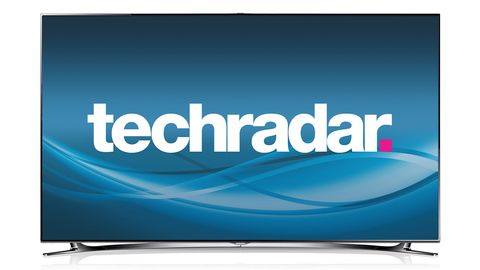Why you can trust TechRadar
While the overall picture quality of Samsung's top-end TVs has generally impressed us for the past few years, getting the best out of them has traditionally meant wrestling with a single flaw: backlight inconsistency, whereby some parts of dark pictures can look cloudy.
The problem has been manageable by being very aggressive in reducing the set's backlight setting, but it's remained the one fly in Samsung's otherwise impressive picture quality ointment.
Why this Samsung backlight history lesson? Because the Samsung UE55F8000 finally sees the brand getting to grips with its traditional enemy, taking Samsung's already impressive picture quality into a whole other stratosphere.
Feed the Samsung UE55F8000 a really dark scene and the screen manages to deliver an excellent black level depth that stretches all the way across the screen with near immaculate uniformity.
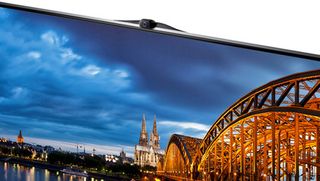
The level of uniformity on show would be impressive with any edge LED TV, but it looks like an even greater achievement in the context of the television's incredibly slender bezel. Quite how any lighting system, never mind a good one, has been fitted in such a small space is anyone's guess.
It's also important to stress that the Samsung UE55F8000's black level response retains much of its depth and nearly all of its uniformity even if you just stick with one of the picture presets the TV ships with - despite the fact that all of these presets, in typical Samsung style, are much too aggressive for our tastes, pushing brightness and contrast too hard despite the damage this does to colour tones and noise levels.
To get the best picture results out of the Samsung UE55F8000's screen, we'd suggest that you take the backlight down all the way to its eight (out of 20) level or less, since this produces both the most natural, nuanced colours and the best balance in dark scenes between rich black colours and good levels of retained shadow detail.
The key point here, though, is that we're not being forced to reduce the backlight setting just to get rid of distracting backlight clouding. It's just a choice we're making to get what seems to us to be the most satisfying, nuanced pictures, at least while watching films in a darkened room.
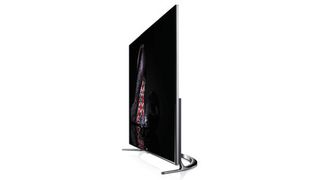
If you prefer pictures that look more punchy and dynamic, or you want a more vibrant, bright picture to counter a light room environment, then the great news is that now you can go for the punchy presets without having your enjoyment spoiled by ugly backlight clouds. Excellent.
Samsung has become so obsessed with tackling its backlight uniformity nemesis, in fact, that it's introduced a handy new Cinema Black feature that dims separately the sections of edge LED lighting that correspond to the black bars you get above and below 21:9 ratio films.
This is because aspect ratio black bars are the single biggest revealer of any backlight inconsistencies an edge LED TV might be suffering with if they're included in the edge LED calculations driving the rest of the picture.
Moving away from the Samsung UE55F8000's startlingly good black level response, the set still delivers the fearsome brightness and colour aggression that's become such an attractive trademark of the Samsung brand over the years.

In fact, the stunning impact of the Samsung UE55F8000's pictures when showing bright, colourful material is emphasised by the incredible slimness of the TV's bezel, since it just looks as if these dazzling, radiant images are appearing pretty much out of nowhere.
Don't let the aggressive nature of its pictures fool you into thinking that the Samsung UE55F8000 isn't interested in the finer things in life, though. On the contrary; thanks to the extra power now available to Samsung's picture processing tools the set delivers even more nuance in colour tones and even more subtle detailing in dark scenes than the brand has ever managed before.
What's more, precious few other TVs have such an uncanny knack for bringing out all the stunning detail in HD footage. So sharp, crisp and textured are its HD pictures, in fact, that they somehow seem to go beyond HD at times.
This isn't always a good thing; grainy Blu-rays and some HD broadcasts can start to look a bit fizzy unless you tone the sharpness setting down a bit. But for much of the time the exceptional clarity is a hugely appealing effect, especially if your TV viewing distance is further than most.
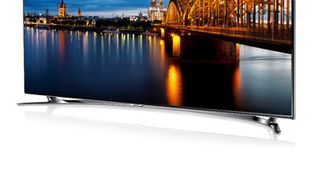
The staggering sharpness and detail of the Samsung UE55F8000 isn't blighted significantly by motion blur or judder, either. Samsung uses native 200Hz panels in its high-end TVs, which operate in tandem with scanning backlights to deliver some of the cleanest, crispest motion we've seen from an LCD TV.
Although some purists would disagree with us, we'd argue that the best motion results are achieved with Samsung's motion processing in play - albeit on its relatively tame Clear setting rather than the Standard mode the set defaults to.
The extra processing power at the Samsung UE55F8000's disposal again helps here, enabling the set to deliver its motion benefits without causing as many negative side effects as previous versions of the system have.
If you really can't stand the idea of using any motion processing, though, don't worry; even with the system turned off, pictures still look cleaner and purer than they do on any of the vast majority of other LCD TVs.
3D pictures
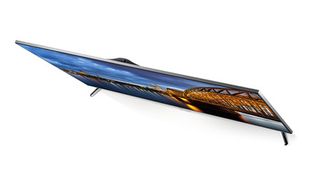
Shifting to 3D playback, if anything it looks even more impressive relative to any previous Samsung TVs than 2D playback. One of the main reasons for this is that motion looks much cleaner and more comfortable within the 3D frame, avoiding the pretty overt judder problems noted in the otherwise excellent Samsung UE55ES8000 last year.
A significant reason for this improved motion handling appears to be that Samsung now has enough processing power at its disposal to apply motion processing to 3D images as well as 2D ones.
If we're correct about this, then you should note that the motion processing involved doesn't appear to be defeatable. But honestly, however purist your tastes it's hard to imagine that you could argue that the motion of last year's Samsung 3D TVs is somehow better than it is on the Samsung UE55F8000.
The Samsung UE55F8000 also improves on last year's 3D models by reducing the amount of crosstalk ghosting noise 3D pictures suffer with. It hasn't been completely removed; distant objects can still show a ghost or two, especially if they're bright objects against relatively dark backgrounds.
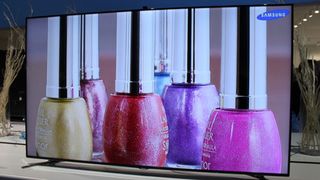
But the problem crops up sufficiently rarely and is subtle enough when it does that it hardly ever becomes a genuine distraction.
What's particularly good about the Samsung UE55F8000's 3D pictures is the way they deliver this reduced crosstalk while retaining - or actually increasing - the brightness and vibrancy that's been a strong Samsung 3D trait since the active 3D format first appeared.
The improved motion handling and crosstalk in 3D mode have a pretty scintillating effect on the sharpness of the Samsung UE55F8000's pictures too, enabling the TV to reproduce every last nuance and texture of the Full HD 3D detailing the active 3D format was developed specifically to deliver.
This fact together with the 3D image's brightness and colour richness means that you don't feel at all as if you're having to compromise anything when switching from 2D to 3D playback.
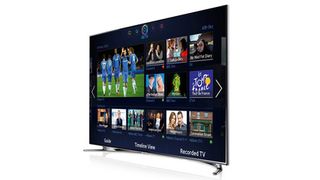
One final excellent point to raise here is that the extra clarity and dynamism of the Samsung UE55F8000's 3D pictures helps the television to produce the most consistent and engaging sense of depth we've seen to date from an active 3D TV.
A search for negative things to say about the Samsung UE55F8000's pictures doesn't get very far. The set's useful viewing angle is rather limited versus plasma and those rival LCD TVs that use IPS panels.
Also, dark scenes don't look as dynamic as they can on Sony's 55HX853, thanks to Sony's use of a local dimming engine. However, Samsung's dark scenes also look more consistent in luminance terms than the slightly uneven appearance delivered by the Sony.
Finally, for the umpteenth time, we still can't understand why Samsung can't manage to include even one picture preset that delivers the sort of subtle, accurate images AV enthusiasts like to see when they've dimmed the lights to watch a film. The set is certainly capable of achieving a suitable setting for this type of use, but you have to calibrate it yourself.
John has been writing about home entertainment technology for more than two decades - an especially impressive feat considering he still claims to only be 35 years old (yeah, right). In that time he’s reviewed hundreds if not thousands of TVs, projectors and speakers, and spent frankly far too long sitting by himself in a dark room.
